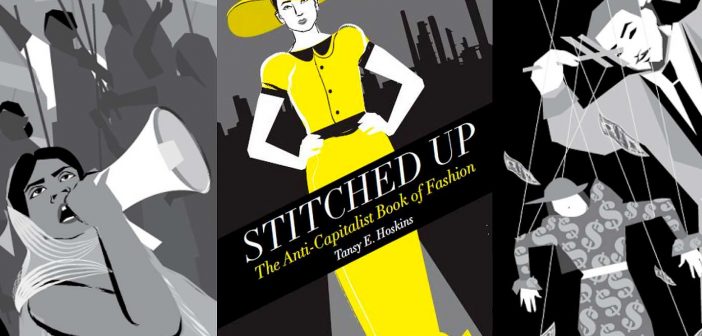Once you see the fashion industry through Hoskins’ anti-capitalist lens what lies behind cannot be unseen.
To compare Stitched Up to Karl Marx’s Communist Manifesto may seem trite, but this book is an equally powerful and compelling critique of capitalism. Readers are not being asked to change their buying habits, but to shatter the illusion that a ‘just capitalism’ can ever exist…
Written by activist and Guardian writer Tansy E. Hoskins and published by the progressive Pluto Press, ‘Stitched Up: The Anti-Capitalist Book of Fashion’ challenges the way we engage with the behemoth that is the fashion industry.
Fashion, Stitched Up argues, ceases to be beautiful art or personal expression under capitalism because it exists primarily as product; product that is inseparable from real human labour. Created by alienated, exploited workers (living wage – 5p per hour) for huge profits that cements a privileged few in power (their net worth? Billions. Eye watering amounts of money).
With the anniversary of the Rana Plaza disaster on April 24th this year what better time to reflect on the world we live in, where the life of one human being is of less value than the contents of another’s wardrobe. In the fashion industry profit comes first, social responsibility second.
Women, as the majority of garment workers, models and fashion consumers are a key focus of the book. The industry undeniably has a firm hold over women’s bodies, labour and lives whilst excluding those not white, rich and thin.
The accepted levels of racism, cultural appropriation and sexual harassment are more subtle forms of oppression that are part and parcel of the industry, and then of course there are the more visible forms of oppression found at the beginning of the production chain.
The problem though “is not simply one of bad companies or bad people at the top of society (though these exist), but of a bad system that produces destructive imperatives,” writes Hoskins.
By making capitalism visible, Hoskins is better able to pick the system apart. What follows is a journey through the history of garment production in the West through to the present day sweatshops of Bangkok and Mumbai, ending with three very significant chapters that question how fashion is used to resist, reform and revolutionize.
The book takes a rigorous unflinching look at the fashion industry’s long list of offences, but Hoskins is not indulging in polemic for its own sake. The contents of Stitched Up calls for tangible revolution.The book takes a rigorous unflinching look at the fashion industry’s long list of offences (reinforcing eating disorders, inhumane treatment of animals, environmental impact of factories and supply chains) but Hoskins is not indulging in polemic for its own sake. The contents of Stitched Up calls for tangible revolution:
“Real, lasting change in the fashion labour system will not happen without an international struggle that creates a world based on the principles of equality, justice and people and planet, rather than capitalism’s competition and profit.”
After the crescendo of the book’s main argument, the tone changes to allow space for contemplation, where readers are invited to envision and dream of a post-capitalist society where collective ownership, social production and democracy allow for creativity to thrive. Where fashion does not exclude, repress, or appropriate but instead values collaboration, solidarity and compassion.
Imagining a very different fashion industry from the one we currently have highlights just how truly corrupt the current system is, ignoring the needs of the many in favour of the wealth and power of a few short-sighted individuals.
Stitched Up wants to leave you feeling uneasy, enraged but also empowered because now you have the hard facts – there is nowhere else to look but the endless amounts of evidence that the system is broken.
The scope of this book is truly impressive and Hoskins’ intellectualisation of fashion is meticulous, and accompanied by beautiful illustrations by Jade Pilgrom. The facts presented are vast in number, always analysed within context and made very real through gritty anecdotes from Hoskins’ own travels and conversations with garment workers on the front line. Her narrative is engaging, angry and there is no doubt that the author has really done her research.
As with any expose/social critique, once you see the fashion industry through Hoskins’ anti-capitalist lens what lies behind cannot be unseen. This is not a passive read but a dialogue to engage with.
Source: For Books’ Sake

